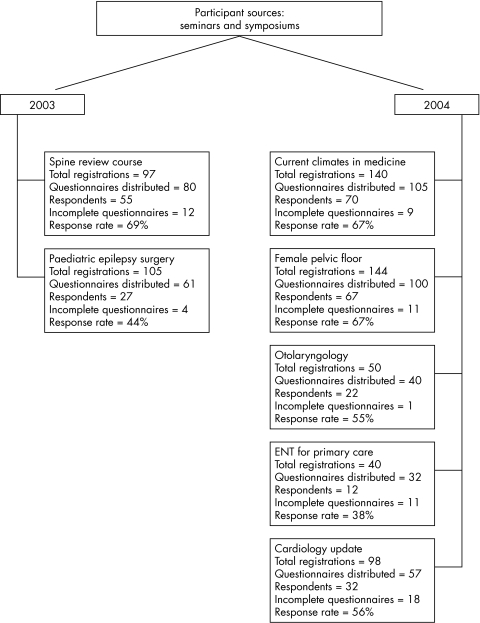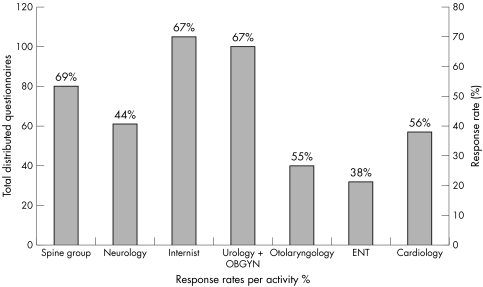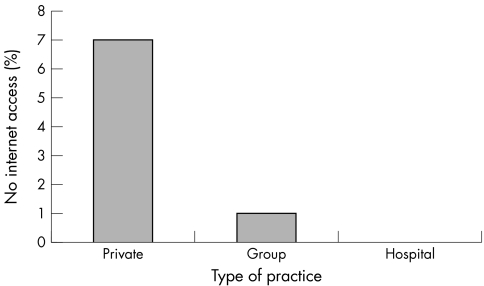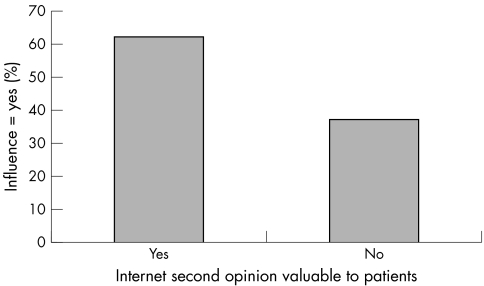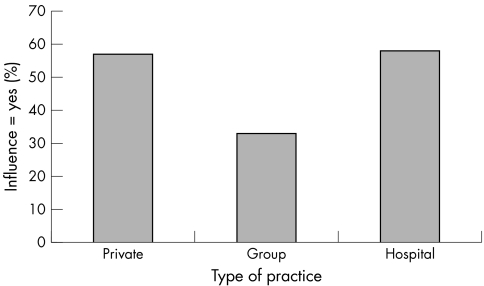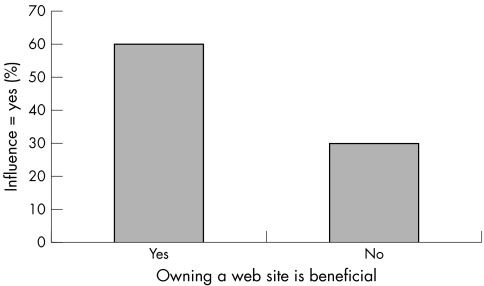Abstract
Purpose
Several studies have explored the scientific platforms on patient use of the internet for health information. In contrast physicians' perspective on evolving internet environment is lacking. The purpose of this study is to assess and correlate the extent of internet use among healthcare professionals and examine its effects on clinical practice.
Methods
Cross sectional survey conducted in the USA using questionnaires distributed randomly to healthcare professionals attending distinct continuing medical education programmes between 2003 and 2004. Multiple choice and yes/no questions related to the trends of internet use and its effects on clinical practice were extracted and responses analysed. The main outcome measures are self reported rates of internet use, perceived effects, and the role of medical web sites in clinical practice.
Results
The overall response rate was 60%. A total of 277 survey respondents (97%) had internet access. Some 7% in private practice and 1% of group practice physicians did not have internet access. Most (71%) used the internet regularly for medical or professional updating and 62% (n = 178) felt the need for sharing web sites designed for healthcare professionals with patients. Some 27% of the physicians currently own established personal practice web sites. Sixty three per cent have recommended a web site to a patient for more information, matching the positive trust (>70%) on the general quality of selected medical web sites.
Conclusion
This cross sectional survey shows that internet use and web based medical information is widely popular among physicians and patients. About 23%–31% of the healthcare professionals report >80% interaction with web informed patients in their daily practice.
Keywords: healthcare information, physician‐patient relationship, internet, medical web sites
Every year more and more patients turn to the internet for medical advice along with physicians for medical updating, making it an important and emerging mass medium. With rapid changes in both technology and the institutions of heath care, online informatics is becoming more central to healthcare services. The widespread availability of medical and scientific information on the internet has a profound impact on physician‐patient relationship.9 The internet is clearly the modern vehicle with the potential to improve information dissemination and perhaps change the way health care is delivered.1,2,3,4,5,6 All this suggests that a predominant paradigm shift is occurring, and the ongoing “information explosion” can be expected to be further fuelled by the rapid progress and universal access to the internet.
Adult patients on the other hand are making significant strides toward using the world wide web. Internet use by physicians has grown from 89% in 2001 to 96% in 2002. Over 90% of physicians use the internet to research clinical issues, making it the most common professional internet activity for physicians.7,8 Additionally, 70% of doctors claim the web has influenced treatment and assisted in the diagnosis of patients.8 Several studies12,17,18,19 in the past explored scientific platforms on patient use of the internet for issues related to disease and health. In contrast physicians' perspective on the evolving e‐medicine environment and experience with patients who have sought internet health information is lacking. We surveyed a representative sample of physicians/healthcare professionals about their experience with the internet with regards to use, influence, and patients' perception of information on the internet. Our objective is to assess the extent of internet use among a cross section of healthcare professionals and to evaluate the effect of web based medical resources for patient care.
Methods
The survey population was drawn from a series of continuing medical education seminars and symposiums organised by the CME department at The Cleveland Clinic Florida during a 12 month period (September 2003 to September 2004). These seminars were chosen randomly but the distribution of questionnaires was consistent within a set criteria. In all seminars the survey was specifically distributed to practising physicians (MD, doctor of medicine, and doctor of osteopathy), and non‐physician participants (such as PhD, nurses, physician assistants (PAs), or physical therapists (PTs)), in both academic and non‐academic settings. The participants should have spent at least 20 hours per week on direct patient care, and formed the study group. Survey participants were asked to assess internet use related to their practice by completing the IUAHP questionnaire (internet use among healthcare professionals).
Categorical responses to items related to type of practice, modes and methods of internet use, and patients' query to web based medical information were collected. No prescreening was conducted before the event. To avoid duplication of this data, specific verbal and written instructions were given to attendees to disregard the questionnaire if previously answered. The questionnaire was developed after peer review and focus group discussions involving three practising physicians and an allied healthcare team consisting a nurse, PA, and a PT. It was pretested internally to ensure that the questionnaire was easy to complete and to avoid ambiguous questions. It took less than three minutes to complete the questionnaire with 15 questions in all. A single version of the survey was created to maintain consistency and maximise the number of responses across different content segments (table 1).
Table 1 Questionnaire responses.
| Item | Total (n = 285) Number | % |
|---|---|---|
| Do you have internet access? | ||
| Yes | 277 | 97 |
| No | 8 | 3 |
| If yes select the type of connection? | ||
| N/A | 22 | 8 |
| DSL/cable | 214 | 75 |
| Dial up | 49 | 17 |
| If you have internet access, where do you have it? | ||
| N/A | 10 | 4 |
| Office | 29 | 11 |
| Home | 41 | 14 |
| Both | 205 | 72 |
| Do you use internet regularly for medical/professional updating? | ||
| N/A | 3 | 1 |
| Yes | 204 | 72 |
| No | 78 | 27 |
| Would you be willing to take certified web based CME courses through a web site? | ||
| N/A | 1 | 0 |
| Yes | 233 | 82 |
| No | 51 | 18 |
| Do you currently have your own personal practice web site? | ||
| N/A | 2 | 1 |
| Yes | 78 | 27 |
| No | 205 | 72 |
| Have patients ever brought printed web based information regarding their condition to you? | ||
| N/A | 2 | 1 |
| Yes | 228 | 80 |
| No | 55 | 19 |
| Would you favour allowing patients to access their information through a web site? | ||
| N/A | 9 | 3 |
| Yes | 178 | 62 |
| No | 98 | 34 |
| Would you favour second opinions for patients via the internet on specific conditions as a valuable resource for patients? | ||
| N/A | 4 | 1 |
| Yes | 165 | 58 |
| No | 116 | 41 |
| Does information from web sites influence your healthcare decisions? | ||
| N/A | 3 | 1 |
| Yes | 145 | 51 |
| No | 137 | 48 |
| Do you believe that owning a web site and communication through it would be beneficial to your patients and practice? | ||
| N/A | 8 | 3 |
| Yes | 201 | 70 |
| No | 76 | 27 |
| Have you ever advised a web site to a patient? | ||
| N/A | 1 | 0.4 |
| Yes | 182 | 64 |
| No | 102 | 36 |
| Has a patient ever asked for the name of a web site for more information on their condition? | ||
| N/A | 3 | 1 |
| Yes | 181 | 64 |
| No | 101 | 35 |
| If yes, have you ever recommended these? | ||
| N/A | 108 | 38 |
| CDC | 20 | 7 |
| WEBMD | 54 | 19 |
| Medlineplus | 10 | 3 |
| AMA‐ASSN | 9 | 3 |
| All | 55 | 19 |
| More than one | 23 | 8 |
| Others | 6 | 2 |
| Do you trust the general quality of medical web sites? | ||
| N/A | 1 | 0 |
| Yes | 207 | 73 |
| No | 77 | 27 |
Statistical methods
Frequencies and percentages were used to summarise the categorical responses. Means, standard deviations, and ranges were used to summarise the continuous responses. The χ2 statistic and Fisher exact tests were used to examine potential associations among the responses. As we had no prior logistic regression, analysis was used to identify an independent set of predictors for the binomial outcome, “Does information from web sites influence your health care decisions?” A p values less than or equal of 0.05 was considered significant.
Results
Response rate
Seven different educational seminars were identified for the survey purpose totalling 674 attendees (fig 1). Of the 674, 73% (475 professionals) met the eligibility criteria (have spent ⩾20 hours per week on direct patient care) to complete a survey. Of the 475, there were 285 surveys completely answered (60% response rate). Figure 2 illustrates the response rate per individual group. Altogether 124 did not participate, and 66 (14%) were incomplete surveys. Overall, complete data were available on 285 respondents, comprising the basis of our data.
Figure 1 Participant flowchart.
Figure 2 Response rates per activity.
Demographics
The mean (SD) age of the cohort was 46 (12.1) years (range, 25–76 years). Sixty seven per cent (n = 192) were MDs; 8% were doctors of medicine; 14% were nurses. and 5% were PAs. The remaining responders (n = 15) were PhDs, MSs, or PTs. Thirty four per cent (n = 96) of the healthcare professionals worked in private practice (sole physician) as compared with 26% (n = 73) in group practice and 41% (n = 116) as hospital employees (non‐academic setting).
Trends and outcomes
Table 1 shows a summary of the individual responses to the items on the questionnaire. Ninety seven per cent of the survey respondents had internet access. More respondents that did not have internet access were from private practice (7%), as compared with 1% for group and 0% for hospital based practice (χ2 = 10.98, df = 2, n = 285) (fig 3). Seventy two per cent of respondents had internet access in both their homes and offices, while 14% had only home access and 10% had access only in the office. Most survey respondents (72%) said they use the internet regularly for medical or professional updating. Eighty one per cent of the physicians stated that they would take web based CME courses and 80% of the physicians had patients present printed web based information on their condition during the office visit.
Figure 3 Percentage of survey respondents without internet access by type of practice.
The main outcome measure analysed is the use of the internet and its perceived effects on healthcare practice. Sixty two per cent of the survey respondents would permit patients to access their information through a web site, and slightly more than half of the survey respondents favoured second opinions via the web as a valuable resource for patients. Similarly, slightly more than half of the physicians claimed that web information does influence their healthcare decisions. In fact, those who favour a second opinion are more likely to claim that the internet influences their decisions (62%), while those who do not favour a second opinion are less likely to claim this influence (37%) (χ2 = 17.00, df = 1, n = 279, χ2 test p<0.001) (fig 4). In addition, those in group practice claimed the least influence of the internet on their healthcare decisions (33% of group practice responders compared with 57% and 58% respectively for private and hospital practices) (fig 5). The main outcome was determined using a χ2 test looking at question 9 (“does information from web sites influence your healthcare practice?”) and correlation with the type of practice. The overall χ2 test was significant, with 51% of respondents indicating that yes, the internet does influence their healthcare practice, and 49% indicating that it does not (χ2 = 12.67, df = 2, n = 282, χ2 p value <0.002).
Figure 4 Percentage of survey respondents who claim internet influences their decision by those who believe internet second opinion is valuable to patients.
Figure 5 Percentage of survey respondents who claim internet influences their decision by type of practice.
Seventy two per cent (n = 207) of healthcare professionals trust the general quality of the medical web sites emphasised by the fact that over 60% of the survey respondents claimed that they advised a patient to visit a web site for further information. A positive recommendation of popular professional web sites (CDC, WebMD, Medline Plus, AMA) to patients was a significant observation. When asked which specific web sites were most often recommended, WebMD and “all of the above” from the list provided were cited most commonly (20%, n = 109). Similarly, over 60% of the physicians had a patient ask them for a web site for additional information on their condition. Not surprisingly, those who believe owning a web site would be beneficial were more likely to claim that the internet influences their decisions compared with those who do not believe it would be beneficial (60% v 30%); (χ2(1) = 19.9, n = 275, p<0.001) (fig 6).
Figure 6 Percentage of survey respondents who claim internet influences their decision by those who believe owning a web site would be beneficial.
Table 2 shows a summary of the results from multivariable logistic regression. The regression showed that various factors as listed in table 2 were significant predictors of acceptance and reliance on the internet. In this study, 80% of the survey respondents reported interaction with web informed patients in their daily practice.
Table 2 Multivariable logistic regression.
| Source | Df | Wald χ2 | p Value |
|---|---|---|---|
| Practice | 2 | 22.73 | <0.001 |
| “If you have internet access, where do you have it?” | 1 | 10.99 | <0.001 |
| “Do you use internet regularly for medical/professional updating?” | 1 | 26.30 | <0.001 |
| “Would you favour second opinions for patients via the internet on specific conditions as a valuable resource for patients?” | 1 | 13.95 | <0.001 |
| “Have you ever advised a web site to a patient?” | 1 | 9.23 | 0.002 |
| “Has a patient ever asked for the name of a web site for more information on their condition?” | 1 | 6.18 | 0.01 |
| “Do you trust the general quality of medical web sites?” | 1 | 21.59 | <0.001 |
Discussion
The widespread availability of medical information on the internet and its effects on health care has exponentially increased over the past decade. Several studies have reported an increasing proportion of the public using the internet for health information.10,11,12 However, information about internet use by the medical community is not well studied. This is the first physician based survey attempted to assess and correlate the extent of internet use among a heterogeneous cross section of healthcare professionals. These data will have substantial implications on health care as the internet emerges at the intersection of medical informatics and public health. We found strong evidence of an increasing use of the internet by physicians and other allied healthcare professionals.
Lack of access to the internet may be a barrier to wider use of online sources of health information.19 This is valid for patients as well as physicians in many aspects. Unfortunately, this facet has never been addressed in the literature. Our study concluded that almost 98% of the clinicians have internet access, with 72% accessing both at work and home. This interest seems to be extending to the willingness to take certified web based CME courses through a web site, with 82% of respondents showing such an interest.
Bates et al16 concluded that on average, each ambulatory visit generates one clinical question that the physician is unable to answer. Instantly accessible, up to date evidence based data should be a standard feature in medical practice. Healthcare professionals conduct millions of Medline searches each year for professional updating17 and our study reiterated this fact with 72% of respondents reporting using the internet regularly for medical and professional updating. None the less, many users find electronic searches to be unproductive and time consuming20 without high speed connections (DSL/Cable/LAN, Broadband/ISDN). There is a significant increase in high speed internet service providers (ISP) emerging in the market along with the consumers using high speed internet. Our study also shows similar results, with 75% of respondents using high speed connections.
Secure, personal practice web pages represent a more comprehensive form of electronic communication between physicians and patients. These can serve multiple purposes, including being a channel of communication, creating a list of diagnoses, drugs, and preventive services, and offering appointment reminders.13,14 Statistics relating to the use and development of personal practice web sites by physicians are completely lacking. The results of our study show that 27% of physicians currently own established personal practice web sites. This reiterates the fact that most healthcare professionals believe that owning a web site would be beneficial to the patients as well as to their practice. Sixty two per cent of the survey respondents would allow patients to access their information through a web site, and slightly more than half of the survey respondents favoured second opinions via the web as a valuable resource for patients. This matches with the survey data by Murray et al21 where patients whose physicians encouraged them to look for information were 58% more likely to talk to their physicians about the information on the internet, as compared with 42% whose physicians did not encourage them to do so.
Electronic interactions provide email communication between provider and patient, inform patients of test results, arrange referrals, and create an improved continuity of care. This avoids difficult scheduling patterns seen in most hospitals. Our study shows that more than 70% of healthcare professionals approve of these beneficial effects of web communication, while only 6%15 of the public use email options to reach their physician. About 20% of adults in the USA use the internet to access health information.18 Holding contrasting views, 53% of users are distrustful of information they find on the internet, as compared with 27% of the physician counterpart we surveyed. More than 70%19 of patients report that internet information influences healthcare decisions, as compared with 51% of the professionals we surveyed.
Limitations
To establish a heterogeneous sample with a mixture of physicians and other healthcare professionals, we chose to distribute our survey at a variety of seminars, instead of sending questionnaires to physicians from different clinics. The use of a convenience sample is a drawback in our study as health professionals coming to educational sessions are not likely to be representative of the population. As many previous studies17,18,19 have reported the trends in web based medical resources for patients, our objective was limited to study the extent of internet use among physicians. Although we randomly chose seven seminars/symposiums, we did not randomly choose the participants to these seminars. For this reason, it was essential to see which seminars/symposiums had a high percentage of respondents, and of those respondents, who used internet resources for their research and patient care. Our surveyed group was not limited to any particular discipline, but the group was varied in an attempt to achieve a heterogeneous representative sample. Although physicians from all over the USA attend these seminars, a significant number of the participants were from our organisation, creating a biased source.
A total of 66 surveys were eliminated from analysis to address the context of missing data (incomplete surveys) in a conservative way. A trend in missing data was not carried out in this study. The p value of the main outcome (p<0.002) indicates significant power to support and justify the results. The important strength of this study lies in its broad inclusion of disciplines in a randomised fashion with a high response rate, and its statistical correlation. With a 64.8% and 96.9% increase in physician and non‐physician participation in ACCME accredited activities in the USA since 1998,22 our survey data have a high impact factor.
Conclusions
This study adds to the literature by describing the physicians' perspective on the evolving internet environment and experience with patients who have sought internet health information. Online communication and internet based interactive web sites lay a strong foundation for patient care. Although the internet is a widely used source of health information in the 21st century, data on accurate estimates of suitability and adaptability, especially within the medical community, are needed. Our study shows that internet use and web based medical information is widely popular among healthcare professionals.
Acknowledgements
We thank Michelle Secic, MS for help with data analysis and Anu Podichetty, MD for literature retrieval. The principal investigator (Vinod Podichetty, MD) had full access to all the data in the study and takes responsibility for the integrity of the data and the accuracy of the data analysis.
Footnotes
Funding: none.
Competing interests: none.
Ethics approval: Institutional Review Board committee approval from the Cleveland Clinic Florida, Weston, Fl, USA was secured for the study reported.
References
- 1.Kassirer J P. The next transformation in the delivery of health care. N Engl J Med 199533252–54. [DOI] [PubMed] [Google Scholar]
- 2.Silberg W M, Lundberg G D, Musacchio R A. Assessing, controlling, and assuring the quality of medical information on the Internet. JAMA 19972771244–1245. [PubMed] [Google Scholar]
- 3.Purcell G P, Wilson P, Delamothe T. The quality of health information on the internet. BMJ 2002324557–558. [DOI] [PMC free article] [PubMed] [Google Scholar]
- 4.Blumenthal D. Doctors in a wired world. Milbank Q 200280525–546. [DOI] [PMC free article] [PubMed] [Google Scholar]
- 5. Gingrich N, Magaziner 1. Two old hands and the new new thing. Health Aff (Millwood) 20001933–40. [DOI] [PubMed] [Google Scholar]
- 6.National Research Council Networking health: prescriptions for the internet. Washington, DC: National Academy Press, 2000 [PubMed]
- 7.Knoop C V, Lovich D, Silverstein M B.et alVital signs: e‐health in the United States. Boston: The Boston Consulting Group, 2003
- 8.Podichetty V, Penn D. The progressive roles of electronic medicine: benefits, concerns, and costs. Am J Med Sci 200432894–99. [DOI] [PubMed] [Google Scholar]
- 9.Kassirer J P. Patients, physicians, and the internet. Health Aff (Millwood) 200019115–123. [DOI] [PubMed] [Google Scholar]
- 10.Lenhart A, Horrigan J, Rainie L.et alThe ever‐shifting Internet population. a new look at internet access and the digital divide. Washington, DC: Pew Internet and American Life Project, 2003
- 11.Eysenbach G, Sa E R, Diepgen T L. Shopping around the internet today and tomorrow: towards the millennium of cybermedicine. BMJ 19993191294. [DOI] [PMC free article] [PubMed] [Google Scholar]
- 12.Shepperd S, Charnock D, Gann B. Helping patients access high quality health information. BMJ 1999319764–766. [DOI] [PMC free article] [PubMed] [Google Scholar]
- 13.Goldsmith J. The internet and managed care. Health Aff (Millwood) 200 1942–56. [DOI] [PubMed] [Google Scholar]
- 14.Dahlberg P K. Web pages get personal for patients. Internet Healthcare Magazine . 2000; Jul/Aug32–34.
- 15.Moyer C A, Stern D T, Dobias K S.et al Bridging the electronic divide. Am J Manag Care 20028427–433. [PubMed] [Google Scholar]
- 16.Bates D W, Ebell M, Gotlieb E.et al A proposal for electronic medical records in US primary care. J Am Med Inform Assoc 2003101–10. [DOI] [PMC free article] [PubMed] [Google Scholar]
- 17.Lindberg D A. MSJAMA: the National Library of Medicine's web site for physicians and patients. JAMA 2001285806. [PubMed] [Google Scholar]
- 18.Baker L, Wagner T H, Singer S.et al Use of the internet and e‐mail for health care information: results from a national survey. JAMA 20032892400–2406. [DOI] [PubMed] [Google Scholar]
- 19.Brodie M, Flournoy R E, Altman D E.et al Health information, the internet, and the digital divide. Health Aff (Milwood) 200019255–265. [DOI] [PubMed] [Google Scholar]
- 20.Hersh W R, Hickam D H. How well do physicians use electronic information retrieval systems? A framework for investigation and systematic review. JAMA 19982801347–1352. [DOI] [PubMed] [Google Scholar]
- 21.Murray E, Lo B, Pollack L.et al The impact of health information on the internet on the physician‐patient relationship: patient perceptions. Arch Intern Med 20031631727–1734. [DOI] [PubMed] [Google Scholar]
- 22. ACCME Annual report data 2003. http://www.accme.org (accessed 18 Nov 2004)



